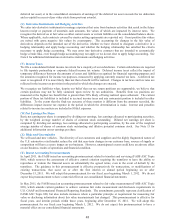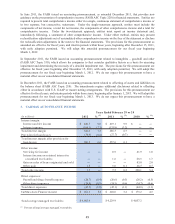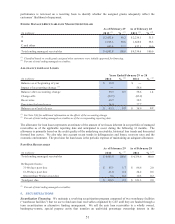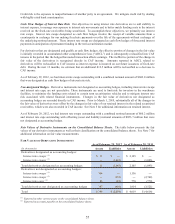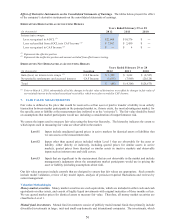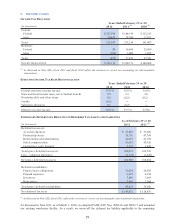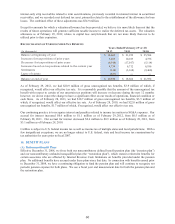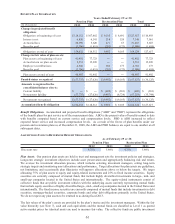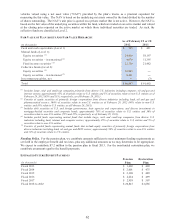CarMax 2012 Annual Report Download - page 58
Download and view the complete annual report
Please find page 58 of the 2012 CarMax annual report below. You can navigate through the pages in the report by either clicking on the pages listed below, or by using the keyword search tool below to find specific information within the annual report.52
receivables, but not the receivables themselves, to entities formed by third-party investors (“bank conduits”). The
bank conduits generally issue asset-backed commercial paper or utilize other funding sources supported by the
transferred receivables, and the proceeds are used to finance the securitized receivables.
We typically use term securitizations to provide long-term funding for the auto loan receivables initially securitized
through the warehouse facilities. In these transactions, a pool of auto loan receivables is sold to a bankruptcy-
remote, special purpose entity that, in turn, transfers the receivables to a special purpose securitization trust. The
securitization trust issues asset-backed securities, secured or otherwise supported by the transferred receivables, and
the proceeds from the sale of the asset-backed securities are used to finance the securitized receivables.
We recognize transfers of auto loan receivables into the warehouse facilities and term securitizations as secured
borrowings, which result in recording the auto loan receivables and the related non-recourse notes payable to the
investors on our consolidated balance sheets. See Note 11 for additional information on our non-recourse notes
payable
Financial Covenants and Performance Triggers. The securitization agreements related to the warehouse facilities
include various financial covenants and performance triggers. The financial covenants include a maximum net
leverage ratio and a minimum interest and rent coverage ratio. Performance triggers require that the pools of
securitized receivables in the warehouse facilities achieve specified thresholds related to loss and delinquency rates.
If these financial covenants and/or thresholds are not met, we could be unable to continue to securitize receivables
through the warehouse facilities. In addition, the warehouse facility investors could charge us a higher rate of
interest and could have us replaced as servicer. Further, we could be required to deposit collections on the
securitized receivables with the warehouse facility agents on a daily basis and deliver executed lockbox agreements
to the warehouse facility agents. As of February 29, 2012, we were in compliance with the financial covenants and
the securitized receivables were in compliance with the performance triggers.
Transition. Effective March 1, 2010, all transfers of auto loan receivables related to the warehouse facilities are
accounted for as secured borrowings. These transfers represent only a portion of the auto loan receivables and this
portion does not meet the definition of a participating interest because our interest in the transferred receivables is
subordinate to the interest of the investors in the bank conduits.
As of March 1, 2010, we amended our warehouse facility agreement in effect as of that date. As a result, auto loan
receivables previously securitized through that warehouse facility no longer qualify for sale treatment because,
under the amendment, CarMax now has effective control over the receivables. The receivables that were funded in
the warehouse facility at that date were consolidated, at their fair value, along with the related non-recourse notes
payable to the investors.
With the removal of the QSPE consolidation exemption from FASB ASC Topic 810, effective March 1, 2010, we
are required to evaluate existing and future term securitization trusts for consolidation. In our capacity as servicer,
we have the power to direct the activities of the trusts that most significantly impact the economic performance of
the receivables. In addition, we have the obligation to absorb losses (subject to limitations) and the rights to receive
any returns of the trusts, which could be significant. Accordingly, we are the primary beneficiary of the trusts and
are required to consolidate them, effective March 1, 2010. The auto loan receivables securitized through the term
securitization trusts were consolidated at their unpaid principal balances as of that date, net of an allowance for loan
losses, along with the related non-recourse notes payable to the investors.
Retained Interest. Prior to March 1, 2010, all transfers of auto loan receivables were accounted for as sales. When
the receivables were securitized, we recognized a gain on the sale and retained an interest in the receivables that
were securitized. The retained interest included the present value of the expected residual cash flows generated by
the securitized receivables, or “interest-only strip receivables,” various reserve accounts, required excess receivables
and retained subordinated bonds. As of February 29, 2012, and February 28, 2011, there was no retained interest, as
all transfers of auto loan receivables were accounted for as secured borrowings.
As part of the adoption of ASU Nos. 2009-16 and 2009-17, as of March 1, 2010, any retained interest related to term
securitizations was either eliminated or reclassified, generally to auto loan receivables, accrued interest receivable or
restricted cash. On March 1, 2010, we also amended our existing warehouse facility agreement. However, this did
not result in the elimination or reclassification of the retained interest related to the receivables that were funded in
the warehouse facility as of that date. In May 2010, we repurchased the remaining portion of those receivables and
resecuritized them through our second warehouse facility established in the first quarter of fiscal 2011. As a result,








